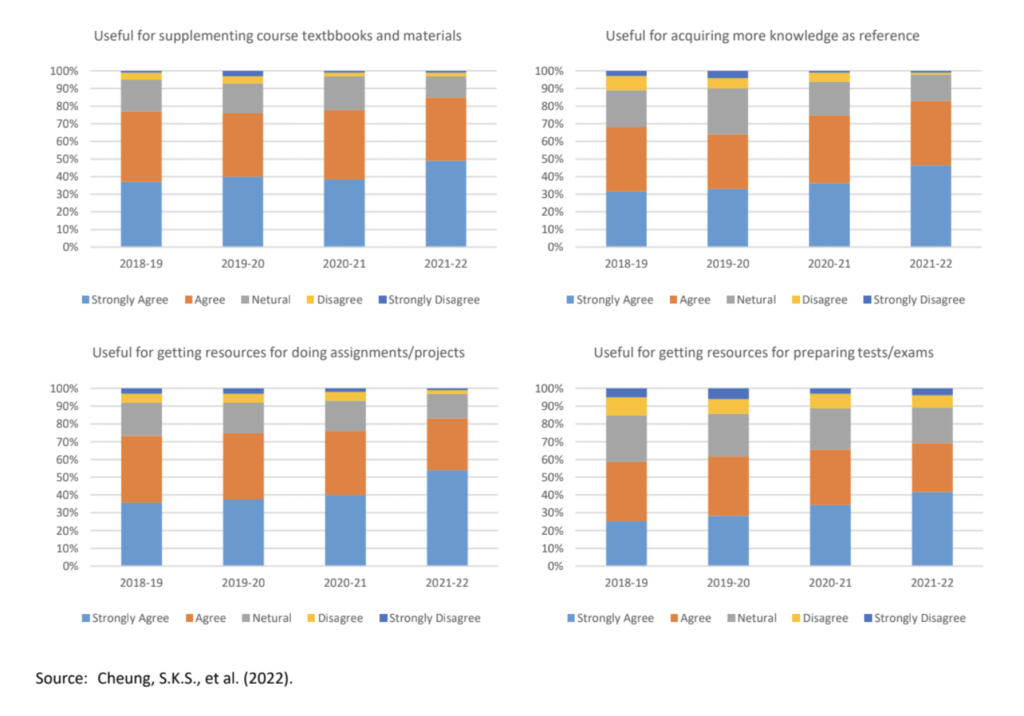By Simon K.S. Cheung, Hong Kong Metropolitan University
Since the outbreak of COVID-19 pandemic, teaching and learning practices have undergone various degrees of transformation to live with different social distancing requirements so caused. Not only in teaching strategies, instructional and content design, there are also changes in learning styles and habits, such as on the use of open educational resources (OER) for teaching and learning. Now, the pandemic is almost over. Many pandemic-driven changes are irreversible, and so are changes on the use of OER? Openly available from the Internet under an open license, OER have evolved as a major source of teaching and learning materials, especially in the higher education context where students get used to use OER. To understand the students’ perceived usefulness of OER, we conducted a 4-year longitudinal study at a public university in Hong Kong, where students were asked on their agreeance on the usefulness of OER for 4 typical learning purposes, i.e. to supplement course textbooks and materials, to acquire more knowledge as reference, to get resources in doing assignments/projects, and to get resources for preparing tests/examinations (Cheung, S.K.S. et al., 2022). Here below highlights some
results.

Our study revealed that students generally consider OER useful for learning, especially as to supplement course textbooks and materials and to get resources for doing assignments and projects, and that their agreeance has become even stronger in the last couple of years since the outbreak of the pandemic. While teaching and learning practices are being transformed, it seems that OER would continue to evolve as an indispensable source of learning materials, and that their usefulness has been more recognized by students than ever before.
Angelopoulou, et al. (2022) studied students’ feedback on the use of OER textbook before and during the pandemic. Whilst no significant difference on the perception of the quality and use of the OER textbook was reported, it was revealed that “students who used the OER textbook more frequently were more likely to have a less positive attitude towards the online format of textbook”, and that “students with higher motivation to learn perceived it as a better
resource than the traditional textbook compared to students with lower motivation to learn.”
Another study on the use of OER for online teaching and learning on mathematics at primary schools in Hong Kong (Lo, et al., 2022) reported that “teachers tended to reply on OER more during the pandemic than before”, and “used OER to introduce mathematics and to facilitate class interactions in online lessons”. The study was also reported that some teachers encountered challenges when using OER, such as on the completeness of the contents, and the suitability for use in the school contexts and for lower primary school students.
For obvious reasons, we can count the pandemic-driven disruption to teaching and learning as one key factor among others that caused changes in the use of OER. The above-mentioned studies are some examples. Look forwards to your opinion and experience-sharing.
References
Angelopoulou, A., et al. (2022). Factors Affecting Student Educational Choice Regarding
OER Material in Computer Science. Journal of Computers in Education, 9(4): 755-781 Springer. DOI: 10.1007/s40692-022-0219-x
Cheung, S.K.S., et al. (2022). Learning in the New Normal Era: Students’ Perception on the Use of Open Educational Resources. In: Li, R.C., et al. (Eds.). Blended Learning: Engaging Students in the New Normal Era. ICBL 2022. Lecture Notes in Computer Science, vol 13357. Springer. DOI: 10.1007/978-3-031-08939-8_30
Lo, C.K., et al. (2022). The Use of Open Educational Resources during the Covid-19 Pandemic: A Qualitative Study of Primary School Mathematics Teachers in Hong Kong. Education Sciences, 2022, 12, 744. MDPI. DOI: 10.3390/edusci12110744

